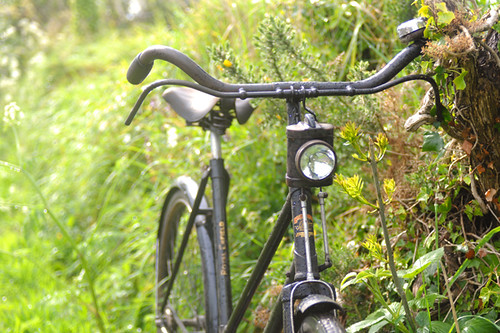
When vintage bicycle collector Chris Sharp invited me to join a VCC ride in Northern Ireland, he also offered to lend me one of his pre-war roadsters and I gladly accepted. We corresponded about this for some time, and I arrived very curious what my loaner bike would be. Before the ride, Chris took me aside and told me he had something very special picked out. "I'd like to know what you think of it."

When he pointed out this bike across the yard, I admit I was a little surprised. It was certainly a nice bike. But considering some of the other machines in his impressive collection, there did not seem anything extraordinary about it: a plain black step-through with rod brakes.
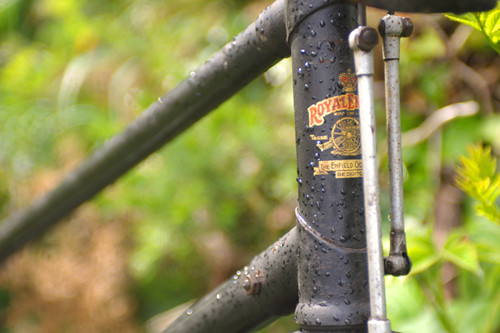
"It's a 1941 Royal Enfield Sports Roadster, single speed, "Chris explained, studying my reaction. "I think you'll like it." Puzzled, I stood there looking at the bike as our group prepared to take off.

Aside from the original Brooks B18 saddle, I just didn't see anything remarkable about it. The drivetrain was in the right place. Nothing eccentric about the components. Ordinary lugwork. I didn't get it.

Furthermore, it occurred to me that riding a heavy ancient single speed with rod brakes was maybe just a tad ill advised in a hilly area with a group of people I'd never met before. Would I have to walk it uphill? Would I be able to stop downhill? But the ride began before I had time to dwell on these questions.

And that is when I learned what the mystery was, and what made this Royal Enfield so special: This bike was a rocket! A 45lb rocket, but a rocket nonetheless. It accelerated at the drop of a hat.It sailed effortlessly uphill. It plunged downhill.Its maneuverability and stability were impeccable.Riding through a stretch of rough gravel road, it rolled jauntily along as if on smooth asphalt.On top of that, the rod brakes actually worked, no worse than modern caliper brakes. "How are you liking that bike?" Chris would ask with a wink. But the answer was pretty clear, as for the entire ride I was in a state of permanent jaw-drop. How could something so old, clunky and seemingly ordinary handle like this?
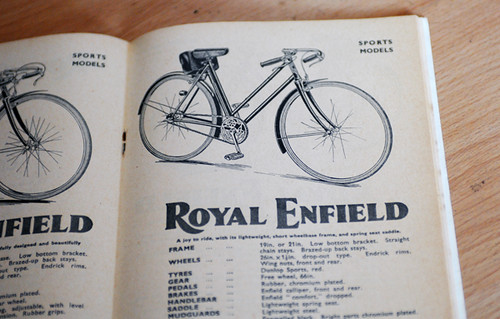
Chris's theory is that this 1941 Royal Enfield happens to be an especially successful specimen of what was once known as the Sports Roadster: an upright model designed for leisure cycling, with more aggressive geometry and a shorter wheelbase than the more stately Roadster model. Raleigh made a Sports Roadster as well, as did most other English manufacturers of that time. The ladies' versions had straight step through frames, instead of the loop frames of the Roadster/Tourist bikes.
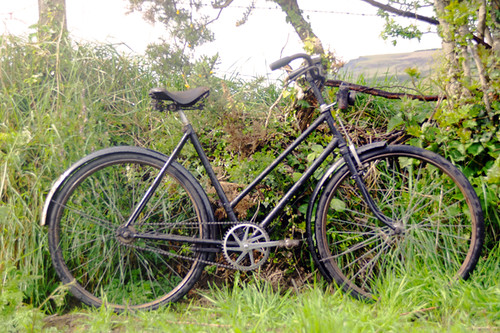
The following week, I paid Chris Sharp another visit and we went on a ride just the two of us. Once again I was given the Royal Enfield - I had to confirm whether my memory of how well it rode had been accurate. We were spectacularly unlucky with the weather that day, and it began to rain not long after we set off. Soon we were riding in a downpour, and by the time we decided to turn around, the shortest route back was 20 minutes. The rain was so bad we could hardly see in front of us.

I would never have imagined that I could ride a bike like the Royal Enfield in such weather, but it was fantastic. It handled no differently in the rain, and - perhaps most amazing of all - the rod brakes remained perfectly functional.

Really, these must be some magical rod brakes. Normally this type of brake is notorious for loss of functionality in wet conditions.
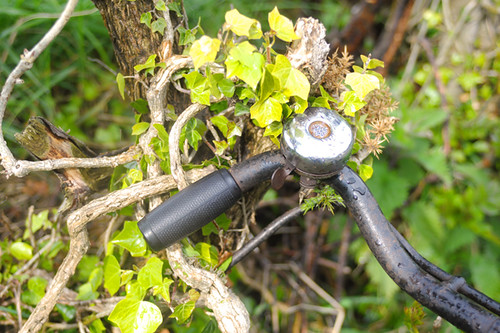
Overall, to say that I was impressed by this bicycle would be an understatement. "They don't make them like they used to" is a cliche I do not always agree with, but in this case it happens to be correct: I do not know of a modern step-through city bike that handles quite like this. Some come close, but this one wins nonetheless.

While a 1941 Royal Enfield Sports Roadster is a pretty obscure bicycle, my point is really more general. I've mentioned before that I tend to prefer the handling of vintage European strep-through city bikes to that of any contemporary version I have tried so far. In my experience, the older bikes tend to be not only more comfortable, but also faster - despite usually being at least as heavy and made of lower quality tubing. What was their secret? And why, with all our technology, can we not match - let alone improve upon - their ride quality today? It is a mystery that I would love to figure out some day.










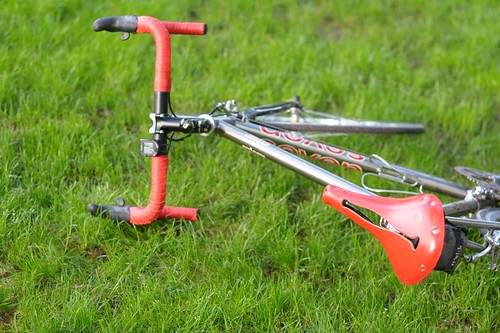

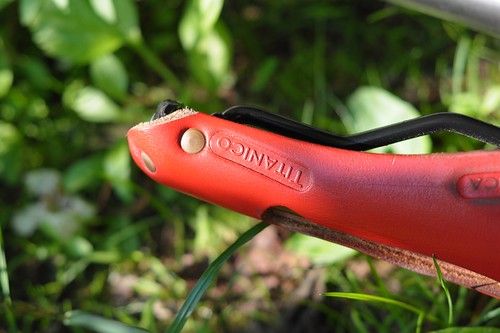
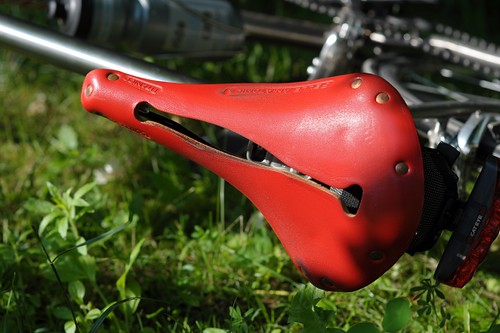
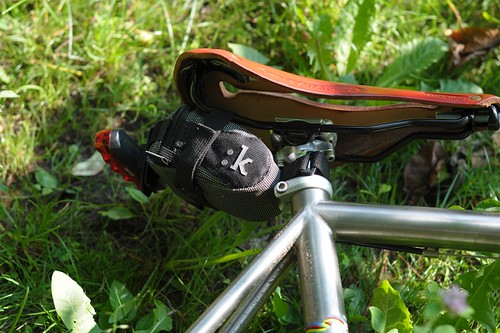
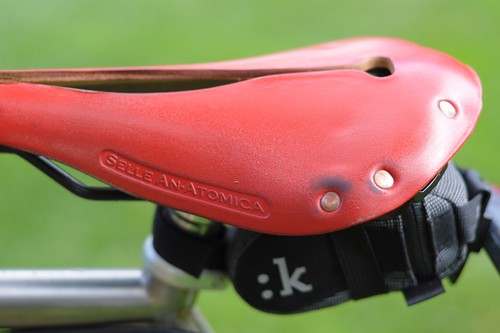





 I didn't find any flowers in the mountains except lots of dandilions. I like dandilions but would have liked some other kinds of flowers to go with them. I did find some moss, or alge, or what ever on a lot of the rocks so took soom close up photos of some
I didn't find any flowers in the mountains except lots of dandilions. I like dandilions but would have liked some other kinds of flowers to go with them. I did find some moss, or alge, or what ever on a lot of the rocks so took soom close up photos of some



 Then it faded to that lovely soft and warm light that gives everything a nice glow. Just beautiful!
Then it faded to that lovely soft and warm light that gives everything a nice glow. Just beautiful! It happens so gradually, you almost miss it if you aren't paying attention. It's like nature's way of letting us slowly unwind at the day's end. Nothing abrupt or jarring about this process. Just nice and easy.
It happens so gradually, you almost miss it if you aren't paying attention. It's like nature's way of letting us slowly unwind at the day's end. Nothing abrupt or jarring about this process. Just nice and easy. It's almost as if it is saying, almost done here for the day folks. We'll be here all night. But you might wanna go ahead and head on home now.
It's almost as if it is saying, almost done here for the day folks. We'll be here all night. But you might wanna go ahead and head on home now.  G'night. Take care. We'll see you tomorrow.
G'night. Take care. We'll see you tomorrow. Last night we were returning home on our bikes. As we approached an intersection where we needed to make a left turn, we signaled and moved to the leftmost part of the lane. A motorist approaching the same intersection behind us began to honk. We turned around, confused. The light had just turned red and all three of us were stopped at the intersection. She continued to honk. We asked what the problem was. She rolled down her window, and the conversation went something like this:
Last night we were returning home on our bikes. As we approached an intersection where we needed to make a left turn, we signaled and moved to the leftmost part of the lane. A motorist approaching the same intersection behind us began to honk. We turned around, confused. The light had just turned red and all three of us were stopped at the intersection. She continued to honk. We asked what the problem was. She rolled down her window, and the conversation went something like this: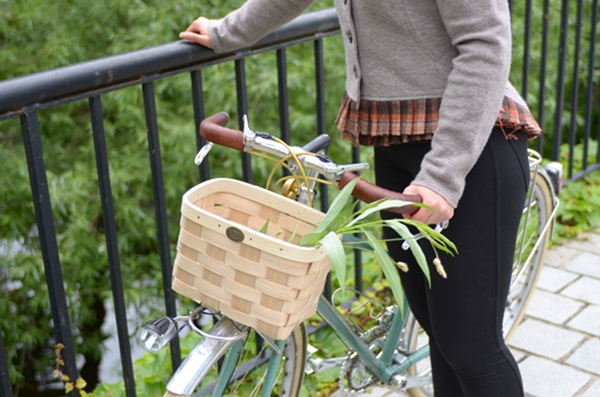 What luck I have. Beset by medical and dental problems simultaneously, the past few days have left me drained. We went for a super slow ride on Saturday, but even that was difficult to manage in my drugged up, diminished lung capacity state. But when we passed Cambridge Bicycle I knew there was one thing that could make me feel better. A basket. Of course. What better cure for life's woes?
What luck I have. Beset by medical and dental problems simultaneously, the past few days have left me drained. We went for a super slow ride on Saturday, but even that was difficult to manage in my drugged up, diminished lung capacity state. But when we passed Cambridge Bicycle I knew there was one thing that could make me feel better. A basket. Of course. What better cure for life's woes?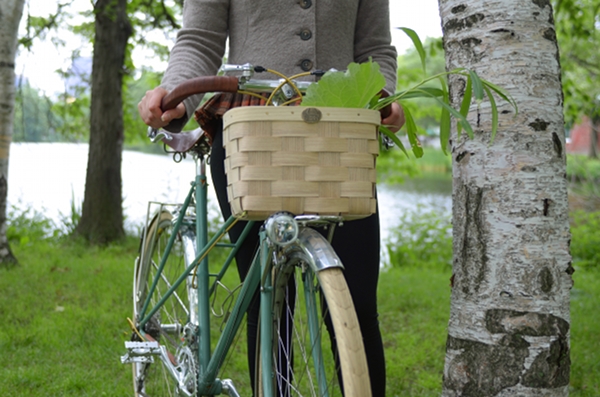 I have been eying this particular basket for months, and finally she is mine! It is made by the Peterboro Basket Companyin New Hampshire, out of locally harvested White Ash. I think the model is this one. This basket is small, boxy, with a rectangular footprint, and it does not taper from top to bottom - which was exactly the style I wanted for this bicycle.
I have been eying this particular basket for months, and finally she is mine! It is made by the Peterboro Basket Companyin New Hampshire, out of locally harvested White Ash. I think the model is this one. This basket is small, boxy, with a rectangular footprint, and it does not taper from top to bottom - which was exactly the style I wanted for this bicycle. I refer to this as Basket 2.0, because I did not get along that well with the large wicker basket on my formerly-owned Pashley, and eventually removed it. This time around I looked for attributes that I hope will work for me.
I refer to this as Basket 2.0, because I did not get along that well with the large wicker basket on my formerly-owned Pashley, and eventually removed it. This time around I looked for attributes that I hope will work for me. For one thing, the Peterboro basket is fairly small, with a low profile and sides that don't stick out too far.It is also feather-light, made of such thin slivers of Ash that it almost feels like Balsa wood. Finally, we attached it directly to a front rack and not to handlebars, which minimises its impact on steering. Though the basket came with leather straps and metal buckles, we removed these and fastened it to the rack with zip ties. The straps and buckles were heavier than the basket itself, so doing this really made it weightless, as well as eliminated any potential jiggling. Cambridge Bicycle were nice enough to give us a handful of zip ties and some wire cutters, and we installed the basket right outside the shop in a matter of minutes.
For one thing, the Peterboro basket is fairly small, with a low profile and sides that don't stick out too far.It is also feather-light, made of such thin slivers of Ash that it almost feels like Balsa wood. Finally, we attached it directly to a front rack and not to handlebars, which minimises its impact on steering. Though the basket came with leather straps and metal buckles, we removed these and fastened it to the rack with zip ties. The straps and buckles were heavier than the basket itself, so doing this really made it weightless, as well as eliminated any potential jiggling. Cambridge Bicycle were nice enough to give us a handful of zip ties and some wire cutters, and we installed the basket right outside the shop in a matter of minutes.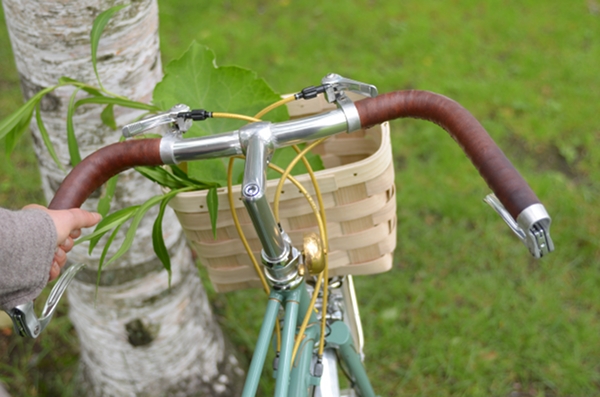 When the basket is empty, I cannot feel it on the bike at all. It does not cause the wheel to flop to the side when the bike is parked.
When the basket is empty, I cannot feel it on the bike at all. It does not cause the wheel to flop to the side when the bike is parked.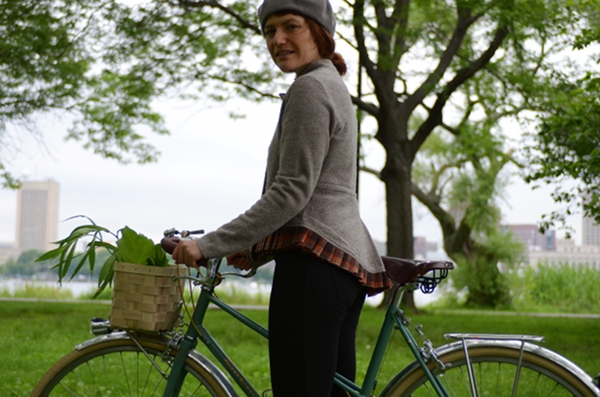 It also leaves the frontmost tip of the tire unobscured, so that I can still see it while cycling. When a huge basket obscures the entire front wheel, I have a harder time feeling connected to the steering, but this is not an issue here.
It also leaves the frontmost tip of the tire unobscured, so that I can still see it while cycling. When a huge basket obscures the entire front wheel, I have a harder time feeling connected to the steering, but this is not an issue here. When the basket is full, the weight feels well distributed and does not interfere with either steering or balance.With dimensions of 10.25" x 7" x 7" it is not meant to carry large objects; I have a rear rack and panniers for that. But the squat, boxy shape allows it to accommodate more stuff than you might think. As pictured above, the basket contains a huge portion of smoked salmon, a bucket of cream cheese, an economy pack of cheese sticks, a blueberry encrusted "goat cheese log," and a flower bouquet. There is room for more.
When the basket is full, the weight feels well distributed and does not interfere with either steering or balance.With dimensions of 10.25" x 7" x 7" it is not meant to carry large objects; I have a rear rack and panniers for that. But the squat, boxy shape allows it to accommodate more stuff than you might think. As pictured above, the basket contains a huge portion of smoked salmon, a bucket of cream cheese, an economy pack of cheese sticks, a blueberry encrusted "goat cheese log," and a flower bouquet. There is room for more.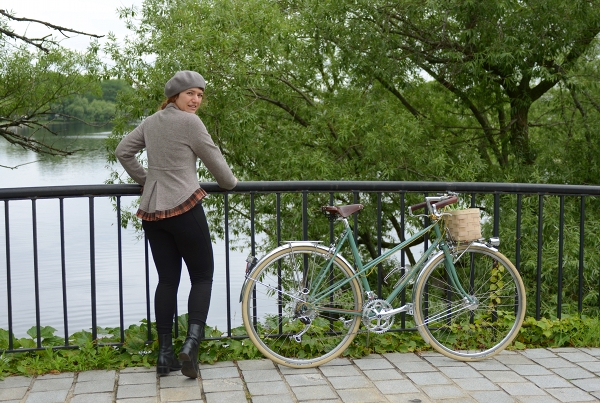 Since I am now using the mixte predominantly as a transportation bike, I wanted to maximise its utility as such. This basket provides a useful space for a jacket, camera, small handbag, or even a quick grocery store purchase, without impacting handling or (to my eye at least) marring the looks of the bike. The Co-Habitant wasn't too crazy about the look at first, but it grew on him. What do you think? What front-mounted basket systems have you used on your bikes, and have they ultimately worked for you? The difference between this set-up and the large, handlebar-mounted basket I used to have on the Pashley Princess is like night and day.
Since I am now using the mixte predominantly as a transportation bike, I wanted to maximise its utility as such. This basket provides a useful space for a jacket, camera, small handbag, or even a quick grocery store purchase, without impacting handling or (to my eye at least) marring the looks of the bike. The Co-Habitant wasn't too crazy about the look at first, but it grew on him. What do you think? What front-mounted basket systems have you used on your bikes, and have they ultimately worked for you? The difference between this set-up and the large, handlebar-mounted basket I used to have on the Pashley Princess is like night and day.